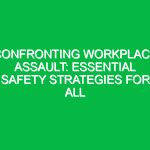Introduction
Working at heights refers to any work conducted at an elevation where a person could fall and sustain serious injury or death. This includes tasks performed on roofs, ladders, scaffolding, and any elevated platform. The relevance of working at heights in the Health, Safety, and Environment (HSE) domain cannot be overstated; it is a significant contributor to workplace accidents and injuries. According to the Health and Safety Executive (HSE), falls from height remain a leading cause of workplace fatalities. Understanding the risks and implementing safety measures is crucial for protecting workers and ensuring compliance with regulations.
In this article, we will explore essential safety tips for working at heights, delve into potential hazards, discuss relevant regulations, and provide actionable insights to promote a culture of safety. The goal is to equip you with a comprehensive understanding of safe practices that can be implemented in your workplace.
Understanding the Risks of Working at Heights
Before diving into safety measures, it’s vital to understand the risks associated with working at heights. These can include, but are not limited to:
- Falls from ladders or scaffolding
- Loss of balance due to slippery surfaces
- Inadequate fall protection measures
- Improper use of equipment
- Environmental factors such as wind or rain
A personal story illustrates these risks vividly. During a roofing project, a colleague of mine slipped while trying to reposition himself on the edge of a sloped roof. Thankfully, he was wearing a harness that was properly secured, which prevented a potentially fatal fall. This incident reinforced the importance of using proper safety gear and being aware of one’s surroundings while working at heights.
Key Safety Tips for Working at Heights
To promote safety while working at heights, consider the following essential tips:
1. Conduct a Risk Assessment
Before commencing work, always perform a thorough risk assessment. Identify potential hazards and evaluate the risks associated with them. This involves examining the working environment, the equipment to be used, and the nature of the work itself. A comprehensive risk assessment will help in formulating a safety plan tailored to the specific job.
2. Use the Right Equipment
Selecting appropriate equipment is crucial. Ensure that all ladders, scaffolding, and platforms are properly rated and maintained. For instance, using a ladder rated for 250 pounds for a job requiring support for 300 pounds could lead to disaster. Always opt for equipment designed for the specific task at hand, and ensure it meets relevant safety standards.
3. Implement Fall Protection Systems
Fall protection systems are essential for safeguarding workers at heights. Depending on the job, this may include guardrails, safety nets, or personal fall arrest systems (PFAS). It’s important to choose the right system based on the height and nature of the work being performed. Training employees on how to correctly use these systems is equally essential.
4. Ensure Proper Training
Training is one of the most effective ways to prevent accidents while working at heights. Workers should be educated on the risks, the correct use of equipment, and emergency procedures. Regular refresher courses can help maintain awareness and reinforce safe practices. In one company I worked with, regular training sessions significantly reduced the number of near-miss incidents related to falls.
5. Maintain a Clear Work Area
Keeping the working area organized can reduce the risk of accidents. Tools, materials, and equipment should be stored safely to prevent tripping hazards. During one construction project, a cluttered site led to a worker tripping over a misplaced tool, causing him to lose his balance on a ladder. A simple cleanup could have prevented this incident.
6. Monitor Weather Conditions
Weather can significantly impact safety when working at heights. Wind, rain, or snow can create hazardous conditions. Before starting work, check the weather forecast and make adjustments accordingly. If conditions are unfavorable, it’s best to postpone work until it is safe to proceed.
7. Use Buddy System
Working with a partner can enhance safety significantly. A buddy system ensures that there is someone to assist in case of an emergency. For instance, if a worker falls or experiences a medical issue, the partner can provide immediate help and alert authorities.
Regulations and Standards Governing Working at Heights
Compliance with regulations is crucial when working at heights. Various standards dictate safety measures that must be followed. In many countries, organizations are required to adhere to regulations such as OSHA (Occupational Safety and Health Administration) standards in the United States or the Work at Height Regulations in the UK.
These regulations typically cover:
- Risk assessment requirements
- Training and competence of workers
- Use of fall protection systems
- Maintenance of equipment
Understanding and implementing these regulations not only enhances safety but also protects organizations from legal repercussions. Non-compliance can result in significant fines and increased insurance premiums, which can be detrimental to any business.
Case Studies and Real-Life Examples
Real-life case studies highlight the importance of adhering to safety measures while working at heights:
Case Study 1: The Roofer’s Fall
In one tragic incident, a roofer fell from a height of 30 feet while installing shingles. Despite being provided with a harness, he chose not to wear it, believing he could complete the job quickly. The fall resulted in severe injuries and a lengthy recovery process. This case underscores the necessity of using personal safety equipment at all times, regardless of how trivial a task may seem.
Case Study 2: Scaffold Collapse
In another example, a scaffolding collapse occurred at a construction site due to improper assembly. Workers were not trained adequately on scaffolding safety, which led to a series of injuries. Following this incident, the company implemented a more rigorous training program and revised its safety protocols, resulting in a significant drop in accidents. This case demonstrates how critical training and adherence to safety standards are in preventing workplace accidents.
Best Practices for a Safe Working Environment
In addition to the safety tips already mentioned, consider these best practices to maintain a safe working environment when working at heights:
- Establish and enforce a safety culture within the organization.
- Conduct regular safety audits and inspections to identify potential hazards.
- Encourage workers to report unsafe conditions or near misses without fear of retribution.
- Provide clear signage and instructions regarding safety equipment and practices.
These practices foster an environment where safety is prioritized and where employees feel empowered to take action to protect themselves and their coworkers.
Conclusion
Working at heights presents unique challenges and risks, but by implementing comprehensive safety measures, organizations can significantly reduce the likelihood of accidents and injuries. By conducting thorough risk assessments, using appropriate equipment, providing proper training, and adhering to regulations, workers can stay secure and protected while performing their tasks.
Promoting a culture of safety not only protects employees but also enhances overall productivity and morale. Remember, safety is not just a requirement; it is a shared responsibility that benefits everyone involved. Take these essential safety tips to heart, and encourage others to do the same, fostering a safer environment for all who work at heights.


